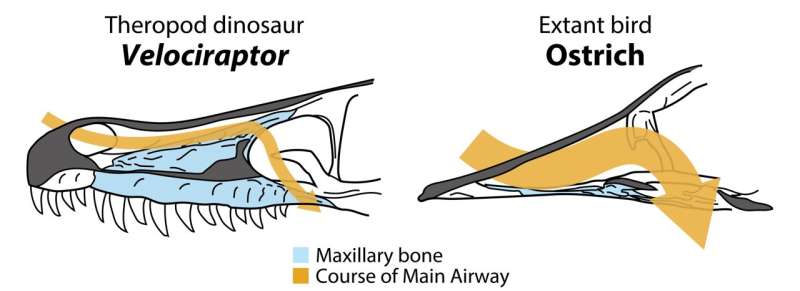This article has been reviewed according to Science X's editorial process and policies. Editors have highlighted the following attributes while ensuring the content's credibility:
fact-checked
peer-reviewed publication
trusted source
proofread
How to cool your brain? These warm-blooded animals use their nose

A research team led by Seishiro Tada and Takanobu Tsuihiji of the University of Tokyo shows that the living warm-blooded descendants of theropod dinosaurs, aided by larger nasal cavities, evolved a better nasal cooling system than cold-blooded animals. The study, published in the journal Royal Society Open Science, provides clues to the evolution of nasal cooling in warm-blooded animals from their theropod dinosaur ancestors.
Endotherms, or warm-blooded animals, maintain their high body temperature through internal heat sources. Birds, humans, and other mammals are endotherms. But ectotherms, or cold-blooded animals such as reptiles, use external heat sources to keep warm. Humans seek air-conditioning or a cold drink on a hot summer day to cool off. How do other animals prevent overheating or frying their heat-sensitive brain? The answer might be in their nose.
In endotherms like birds, mammals, and you, the nose not only sniffs out scents and stenches but also aids in heat exchange thanks to the small undulating scroll-shaped structures called respiratory turbinates made of bone and cartilage tissue. They may help moisten the inhaled air, and exchange heat from the circulating blood, which can cool the brain.

A previous study showed that the size of the nasal cavity in ectotherms and endotherms correlates with body size. "But its physiological role has been controversial," said Seishiro Tada, a graduate student at the University of Tokyo. Does a large nasal cavity help maintain the whole-body temperature through blood circulation or simply cool the large brains of endotherms? If it is to cool their brain, endotherms with larger brains might have larger nasal cavities and efficient cooling aided by turbinates. To test that, the researchers aimed to clarify the primary role of respiratory turbinates and the physiological function of the nasal cavity of non-avian dinosaurs and their living descendants.
The team studied the head specimens of 51 present-day endotherms and ectotherms, and a skull of a theropod dinosaur called Velociraptor mongoliensis using computer tomography or CT scans and recreating their nasal structures. They found that compared to ectotherms, endotherms have well-developed turbinates and a relatively larger nasal cavity for their head size—and not body size as previously thought. This means that the large nasal cavity helps cool their brain.
The researchers also found that the nonflying theropod dinosaur Velociraptor mongoliensis had a smaller nasal cavity and hence couldn't regulate temperature as efficiently as its present-day descendants, birds, hinting at a relatively less developed brain that did not need an efficient cooling. Perhaps they used other ways of cooling their hot brain; it is still a mystery. The nasal cooling system may have evolved in parallel with changes in their skull structure that we now see in modern endotherms.

Tada was pleasantly surprised by "the possible scenario of the skull evolution seen in the dinosaur-bird lineage nobody had ever noticed before." He noted, "Our findings highlight the importance of the nose in inferring the physiology of fossil forms such as dinosaurs and enable us to study the evolution of drastic skull modification from the nonflying theropod dinosaurs to modern birds from a new angle."
More information: Evolutionary process toward avian-like cephalic thermoregulation system in Theropoda elucidated based on nasal structures, Royal Society Open Science (2023). DOI: 10.1098/rsos.220997. royalsocietypublishing.org/doi/10.1098/rsos.220997
Journal information: Royal Society Open Science
Provided by University of Tokyo




















